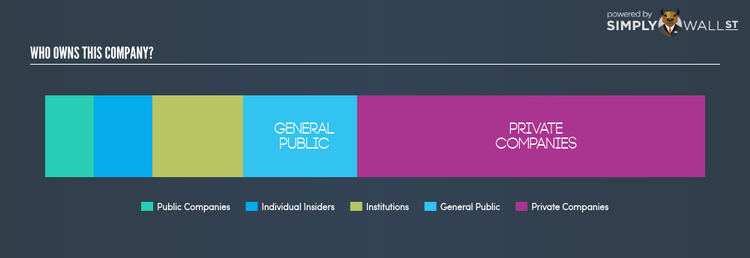Who Are The Largest Shareholders In Boryszew SA. (WSE:BRS)?

In this article, I will take a quick look at Boryszew SA.’s (WSE:BRS) recent ownership structure – an unconventional investing subject, but an important one. Ownership structure of a company has been found to affect share performance over time. Differences in ownership structure of companies can have a profound effect on how management’s incentives are aligned with shareholder returns, which is why we’ll take a moment to analyse BRS’s shareholder registry.
Check out our latest analysis for Boryszew
Institutional Ownership
BRS’s 36.04% institutional ownership seems enough to cause large share price movements in the case of significant share sell-off or acquisitions by institutions, particularly when there is a low level of public shares available on the market to trade. Although BRS has a high institutional ownership, such stock moves, in the short-term, are more commonly linked to a particular type of active institutional investors – hedge funds. For BRS shareholders, the potential of this type of share price volatility shouldn’t be as concerning as hedge fund ownership is is not significant,indicating few chances of such sudden price moves. While that hardly seems concerning, I will explore further into BRS’s ownership type to find out how it can affect the company’s investment profile.
Insider Ownership
Another important group of shareholders are company insiders. Insider ownership has to do more with how the company is managed and less to do with the direct impact of the magnitude of shares trading on the market. BRS insiders hold a significant stake of 22.91% in the company. This level of insider ownership has been found to have a negative impact on companies with consistently low PE ratios (underperformers), while it has been positive in the case of high PE ratio firms (outperformers). Another aspect of insider ownership is to learn about their recent transactions. Insider buying may be a sign of upbeat future expectations, however, selling doesn’t necessarily mean the opposite as insiders may be motivated by their personal financial needs.
General Public Ownership
The general public holds a substantial 44.86% stake in BRS, making it a highly popular stock among retail investors. With this size of ownership, retail investors can collectively play a role in major company policies that affect shareholders returns, including executive remuneration and the appointment of directors. They can also exercise the power to decline an acquisition or merger that may not improve profitability.
Private Company Ownership
Another group of owners that a potential investor in BRS should consider are private companies, with a stake of 136.88%. While they invest more often due to strategic interests, an investment can also be driven by capital gains through share price appreciation. This kind of ownership, if predominantly strategic, can give these companies a significant power to affect BRS’s business strategy. Thus, potential investors should look into these business relations and check how it can impact long-term shareholder returns.
Next Steps:
BRS’s considerably high level of institutional ownership calls for further analysis into its margin of safety. This is to avoid getting trapped in a sustained sell-off that is often observed in stocks with this level of institutional participation. However, ownership structure should not be the only focus of your research when constructing an investment thesis around BRS. Rather, you should be looking at fundamental drivers such as Boryszew’s past track record and financial health. I urge you to complete your research by taking a look at the following:
Future Outlook: What are well-informed industry analysts predicting for BRS’s future growth? Take a look at our free research report of analyst consensus for BRS’s outlook.
Past Track Record: Has BRS been consistently performing well irrespective of the ups and downs in the market? Go into more detail in the past performance analysis and take a look at the free visual representations of BRS’s historicals for more clarity.
Other High-Performing Stocks: Are there other stocks that provide better prospects with proven track records? Explore our free list of these great stocks here.
NB: Figures in this article are calculated using data from the last twelve months, which refer to the 12-month period ending on the last date of the month the financial statement is dated. This may not be consistent with full year annual report figures.
To help readers see pass the short term volatility of the financial market, we aim to bring you a long-term focused research analysis purely driven by fundamental data. Note that our analysis does not factor in the latest price sensitive company announcements.
The author is an independent contributor and at the time of publication had no position in the stocks mentioned.

 Yahoo Finance
Yahoo Finance 
